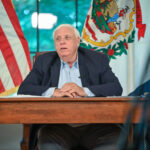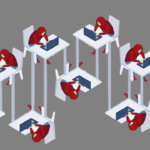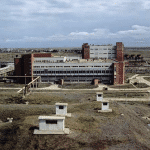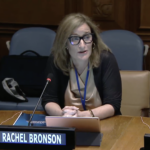DIY biology
By Laura H. Kahn | June 18, 2012
In the nineteenth century, research in the natural and life sciences was largely self-supported. Charles Darwin had the good fortune of being born into a wealthy family, enabling him to pursue his passions as a gentleman naturalist and to develop the trailblazing theory of evolution. Darwin’s good fortune ended up being science’s as well. Not incidentally, Darwin also had great connections: His botany professor at Cambridge recommended Darwin as a “scientific person” to Robert FitzRoy, captain of the HMS Beagle. Darwin spent five years traveling on the Beagle and studying the zoology, botany, and geography of new lands.
A free trip around the world to study the natural history of exciting new places? What “scientific person” wouldn’t sign up?
Of course, not everyone who wanted to explore the natural sciences had Darwin’s financial advantages. Gregor Johann Mendel, the son of a peasant farmer, became a priest and did his research in addition to his duties as a friar. At the Augustinian Abbey of St. Thomas, Mendel conducted plant-hybridization experiments on a four-acre plot using 10,000 pea plants. He obsessively checked his results, kept meticulous records, and used sophisticated mathematical analysis for his research. Fortunately, Mendel’s abbot in charge of the monastery fully supported his scientific endeavors. As a result, Mendel was able to lay the groundwork for the field of genetics and to provide the scientific basis for Darwin’s theory of evolution.
In the twentieth century, state-of-the-art biology largely moved from the natural world to high-tech laboratories, where it became prohibitively expensive to conduct self-funded research.
Not anymore.
Welcome to the new millennium of do-it-yourself (DIY) biology. Advances in technology in the twenty-first century have enabled anybody, with the desire and the disposable income, to build rather sophisticated laboratories in their own homes. Entire communities have even materialized to promote these efforts — like the thousands of amateur biologists who contribute to DIYbio.org, a website “dedicated to making biology an accessible pursuit for citizen scientists, amateur biologists and biological engineers.”
But the DIY biology crowd has left security experts scratching their heads. Are home laboratories a good or bad thing?
First, the downside: Obviously, in an unregulated and unsupervised environment, there’s always the risk of a lone-wolf scientist developing a doomsday bug in his or her garage. President Bill Clinton was so frightened by Richard Preston’s 1998 novel, The Cobra Event — which depicted a crazed scientist creating a deadly bioweapon in his Manhattan apartment — that he decided to target government funds to fight bioterrorism. Today, those fears are potentially more grounded in reality than ever. A glance at the DIYbio discussion boards currently has more than 3,300 ongoing conversations about everything from bacterial DNA and biohacking to finding the best prices for centrifuges and thermocyclers.
Adding to the threat of rogue amateur bioterrorists is the nearly impossible task of tracking down biocrime perpetrators. Let’s not forget that the FBI never conclusively solved the 2001 anthrax murders. Unfortunately, solving biocrimes is extremely difficult to do. Following the anthrax attacks, the FBI became so jumpy about home laboratories that, in 2004, they went so far as to arrest a University of Buffalo professor who used bacteria in his artwork at home. (The terrorism charges against him were subsequently dropped.) Luckily, the FBI has come a long way since then and is now engaging the academic, industrial, and home biology communities with WMD coordinators in each of their 56 field offices. The FBI has learned that the best prevention strategy is open and congenial communication.
This brings us to the upside of the home biology movement. In his book, Biology is Technology, Robert Carlson — a principal at Biodesic, a biotech consulting firm — reminds us that many of the world’s greatest advances in science and technology have, after all, taken place in garages. Where would aviation be without hobbyists and tinkerers?
In the late 19th century, French-born and self-taught railroad engineer Octave Chanute retired to Chicago and decided to solve the challenge of flight. Just like the DIY crowd, Chanute cultivated a cadre of likeminded aviation pioneers to share data and experiences — including Orville and Wilbur Wright. The Wright brothers took Chanute’s suggestions to the next level by using their knowledge of bicycle design to successfully build and fly an aircraft. Their hard work and ingenuity provided the foundation for the modern airline industry.
And, of course, there is perhaps the planet’s most famous garage lab: Apple Inc. Steve Jobs and Steve Wozniak developed the prototypes for personal computers first in Jobs’s bedroom and later, when they ran out of space, in his garage. The rest, of course, is iHistory.
Carlson believes that the next revolution in biotechnology is also likely to take place in someone’s home or start-up laboratory. Unlike formally trained scientists, self-taught biologists may think a bit more outside of the box. Developing the next-generation vaccines and anti-microbials, and autologous replacement organs — which have the potential to completely transform medicine and public health — is going to take novel, visionary approaches. Start-up biotechnology efforts and their creative DIY enthusiasts, like Jobs and Wozniak, have the potential to fuel the economy with thousands of new jobs. Carlson estimates that revenue from “genetically modified stuff” in the United States is about $300 billion annually — more than 2 percent of gross domestic product — and growing at an annual rate of about 15 to 20 percent.
So while there are certainly risks, the upside to DIY biotech is tremendous. The challenge in a global economy is that people across the planet are also self-funding biotech work in garages and small start-up labs; some are even becoming fabulously wealthy. Kiran Mazumdar-Shaw started Biocon in her garage, making industrial enzymes; today, Biocon is the largest biotech firm in India. So for those of you with the interest, stamina, funds, and a small garage or start-up laboratory, your idea just might be the next breakthrough discovery.
Together, we make the world safer.
The Bulletin elevates expert voices above the noise. But as an independent nonprofit organization, our operations depend on the support of readers like you. Help us continue to deliver quality journalism that holds leaders accountable. Your support of our work at any level is important. In return, we promise our coverage will be understandable, influential, vigilant, solution-oriented, and fair-minded. Together we can make a difference.
Topics: Biosecurity, Columnists















